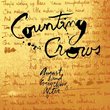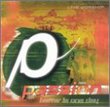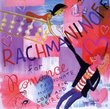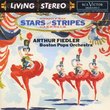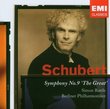| All Artists: Anne Akiko Meyers, Akira Eguchi Title: Smile Members Wishing: 1 Total Copies: 0 Label: Koch Int'l Classics Original Release Date: 1/1/2009 Re-Release Date: 1/27/2009 Genres: International Music, Special Interest, Pop, Classical Styles: Latin Music, Tango, Vocal Pop, Chamber Music, Historical Periods, Classical (c.1770-1830) Number of Discs: 1 SwapaCD Credits: 1 UPC: 099923776222 |
Search - Anne Akiko Meyers, Akira Eguchi :: Smile
 | Anne Akiko Meyers, Akira Eguchi Smile Genres: International Music, Special Interest, Pop, Classical
Violinist Anne Akiko Meyers' triumphant label debut on Koch International Classics highlights a beguiling program of the traditional and new. Stretching the boundaries of the classical recital, Meyers, with fellow Juillia... more » |
Larger Image |
CD DetailsSynopsis
Album Description Violinist Anne Akiko Meyers' triumphant label debut on Koch International Classics highlights a beguiling program of the traditional and new. Stretching the boundaries of the classical recital, Meyers, with fellow Juilliard graduate, pianist Akira Eguchi, turns her renowned talents to Schubert's Fantasie, Op. 159, Arvo Pärt's Spiegel im Spiegel, the U.S. premiere of the Messiaen Fantasie, Piazzolla's Introduction et Angel and Milonga en Re "Tango," two ravishing arrangements of traditional Japanese folk songs, Kojo no Tsuki (Moonlight Over the Ruined Castle) and Haru no Umi (Sea in Spring), as well as startlingly personal renditions of Somewhere Over the Rainbow and Chaplin's Smile. Meyers will perform recitals of the CD's repertoire with Eguchi at the University of Texas in Austin on April 23, 2009 and New York's Queens College on April 26, 2009. She also appears with orchestras this season throughout the U.S., as well as in Japan, the U.K. and Columbia. "The pieces on this album have a purity of sound, and they immediately grab at you," remarks Meyers. "The mood of the recording is reflective - a palette of colors, with each piece an expression of my life as an artist." The culture of Japan is a crucial thread running through the album. "I spent a lot of time in Japan as a child and tour there frequently, so it's very close to my heart. The Japanese pieces are music that I've played in Japan many times; Kojo no Tsuki (Moonlight Over the Ruined Castle) is one of the most popular works in Japan and if you go to almost any Japanese restaurant you will hear Kojo in the background!" The impressionistic arrangement of Haru no Umi (Sea in Spring) presents the listener with an aural surprise: "The piece was originally written for a shakuhachi (bamboo flute), so in the recording the piano was specially prepared by our technician to emulate the sound of a koto, and I tried to get my 1730 Stradivarius to sound like a shakuhachi! The piece is incredible - the piano sounds exactly like a koto." Some of the album's European and American works are also touched by the charms of Japan: "Messiaen actually spent time in Japan and was deeply influenced by the culture, especially Noh theatre, and Pärt's Spiegel im Spiegel is reminiscent of Japanese music with its long notes and the significance of the spaces between them." While Meyers categorizes the recordings two works by Piazolla as "sexy, exquisite jewels" and the two standards, "Somewhere Over the Rainbow" and "Smile," as "gemlike; two of the greatest songs, they just make your heart whistle," there is an undeniably bittersweet, reflective quality to many of the works on the album. Schubert wrote his Fantasie in the last year of his short life, and Kojo no Tsuki composer Rentaro Taki died at 23. Meyers views Pärt's Spiegel im Spiegel as "a very mystical journey, beautiful and introspective" and also comments on the Piazolla pieces being steeped in feelings of nostalgic longing: "There are moments that are so incredibly sad, like something that you wish you had that's not there anymore. That's the feeling of a tango to me." The story of Messiaen's Fantasie, receiving its U.S. premiere, is heartbreaking: it was written for his first wife, a violinist and mother of his son, who ended up living in mental institutions for the rest of her life. The work was rediscovered by his second wife and only brought to light recently. And the soulfully moving renditions of Charlie Chaplin's "Smile" and Harold Arlen's "Somewhere Over the Rainbow become startlingly personal statements in Meyers' hands, the latter in a world premiere arrangement written by the Japanese jazz pianist Makoto Ozone. But it is Kojo no Tsuki in a world premiere arrangement written by Meyers and composer Shigeaki Saegusa that could well be the most poignant: "It's the story of how a castle has seen better days - it has a faded glory - but a beautiful moonlight shines down on the it. The moonlight remains constant, but the castle has changed, and it's so true for so many things in life: things constantly change, yet they're also the same. It's especially resonant for me because my aging grandmother lives in Japan, and I'm not able to see her often enough. She really loves this work and I co-arranged and recorded it specifically for her." Starting her studies at age four, Anne Akiko Meyers first performed with a local orchestra at the age of seven, then burst into national prominence at age eleven, when she twice performed on `The Tonight Show' with Johnny Carson and appeared with the Los Angeles Philharmonic. The following year she made her New York Philharmonic debut with Zubin Mehta conducting. She was soon performing throughout the United States, Japan, Australia and Europe and by the time her debut disc of the Barber and Bruch violin concertos was released at age 18, she was recognized as one of the stars of her generation. Hailed by critics and audiences worldwide, Meyers' impassioned performances, compelling music making and mastery of a broad and varied selection of music have made her one of today's most sought-after violinists. A renowned soloist, chamber musician, recording artist and educator, Meyers has been a regular guest at some of the most prestigious orchestras and venues. In addition to her Koch debut, Meyers' extensive discography can be found on the Avie, Camerata, Hyperion, Naxos, RCA Victor Red Seal and RPO labels. A best-selling recording artist, she seeks to reach wider audiences through new works and showcasing under-performed or rarely heard music; recordings of works written expressly for her include a live performance of the Somei Satoh Violin Concerto with Tetsuji Honna and the Tokyo Metropolitan Orchestra on the Camerata label, and 'Angelfire' by Pulitzer-prize winning composer Joseph Schwantner with Andrew Litton and the Dallas Symphony Orchestra on Hyperion. Naxos also released a performance of Jennifer Higdon's piano trio, featuring Meyers, live from the Bravo! Vail Valley Music Festival. Meyers' numerous television credits include an A&E Network telecast from the Casals Festival with the Montreal Symphony and Krzysztof Penderecki, a PBS broadcast with the Boston Pops Orchestra and John Williams, and an appearance on the "Emmy Awards Show". She was featured in a live global Internet broadcast with Keith Lockhart and the Royal Concertgebouw Orchestra, performed in front of some 750,000 people during Sydney's 250th Bicentennial celebrations, and has performed for dignitaries including the Emperor and Empress of Japan. She has also been featured in numerous print and television ads, including the Anne Klein "Women of Substance" fashion campaign, photographed by Annie Leibovitz, that appeared in magazines around the world. Anne Akiko Meyers studied with Alice and Eleanore Schoenfeld at the Colburn School of Performing Arts in Los Angeles, with Josef Gingold at Indiana University, and Felix Galimir, Masao Kawasaki and the late Dorothy DeLay at the Juilliard School. The recipient of an Avery Fisher Career Grant, she performs on the "Royal Spanish" Antonius Stradivarius violin, dated 1730, that once belonged to the King of Spain. Similarly Requested CDs
|
CD ReviewsShe is a songstress even if she is a violinist! Steve Wehmhoff | East Northport NY United States | 02/02/2009 (5 out of 5 stars) "Anne Akiko Meyers new CD 'Smile' is an wonderful tour of the world of song. From her readings of two great standadrds, Smile from the film Modern Times by Charlie Chaplin and Somewhere over the Rainbow by Harold Arlen from the Wizard of Oz to her duplicating bird songs in Messiaen's Fantasie to the Japanese folksongs that she arranged herself. Ms. Meyer's tone has always been luminous but her new 1730 Stradivarius violin (The Royal Spanish) adds a dark timbre to the bottom of each note. It's almost like listening to a new violinist. The centerpiece of the recording is the Schubert Fantasie that is flanked on either side by the songs. As Schubert composed hundreds of songs (Lieder) that charactersitic is what Meyers brings to this excellent performance. It is almost as if Anne Akiko Meyers is embarking on a mew career as aviolinist and has decided that she won't be held in by any arbitrary boundaries out on her musically. I love this CD and I have not stop playing it since I got it. I heartily recommend this CD." 4 STARS from BBC Music Magazine music7lover | 01/28/2009 (5 out of 5 stars) "Anne Akiko Meyers's album opens with Charlie Chaplin's Smile and ends with `Somewhere over the Rainbow'; along the way Japanese folksong is set alongside Pärt, Piazzolla and Messiaen. At its heart is the great Schubert Fantasy, D934, rapt and almost heartbreaking at the start, Akira Eguchi's accompanying tremolando exquisitely judged; but what follows relocates Schubert towards the end of the 19th century. Yet Meyers's beautiful sound and control pay dividends in Pärt's crystalline Spiegel im Spiegel. 4 STARS" Utterly stunning Penny | New Rochelle | 02/05/2009 (5 out of 5 stars) "This album is superior in too many ways to list! The performances here are so intimate and warm. There's a personal nature to this recording that at times I felt like I peering through the window into Anne's soul. The quality of the audio on this disc is superior to many other violin recitals -- the crisp, clean sound of the instruments jumps through the speakers. Highly highly recommended."
|

 Track Listings (12) - Disc #1
Track Listings (12) - Disc #1